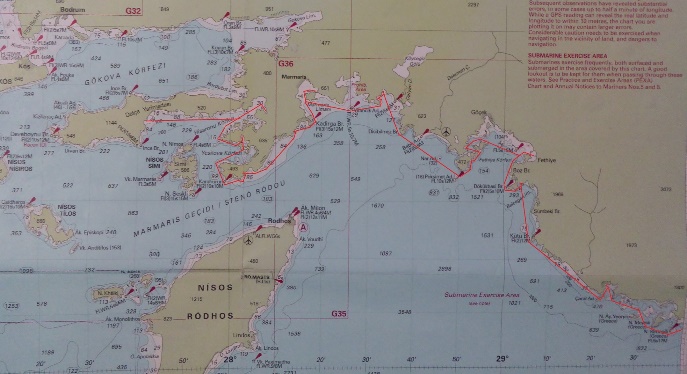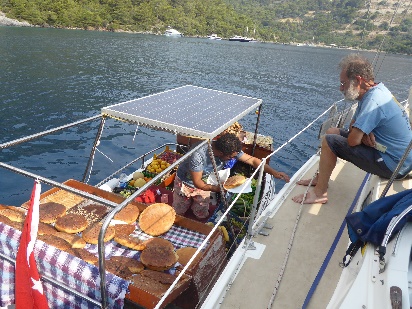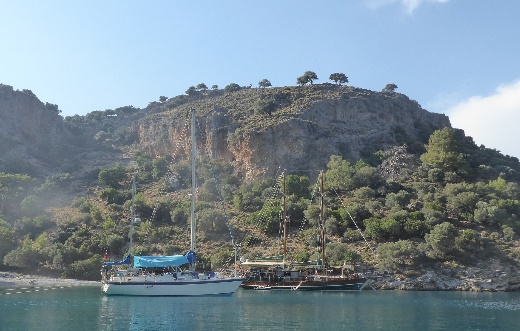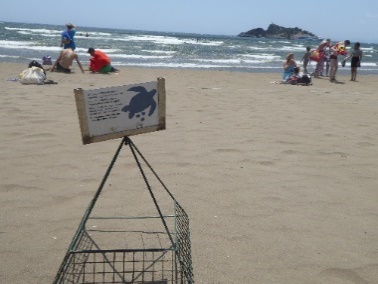June 2018 : South-West Turkey
LaterEarlier |
Selamar from Turkey at the end of our first month’s cruising. 
Our plans this year are a little more ambitious than usual. So far, since we crossed from the UK to France in 2010, our route has involved, more or less, keeping the mainland on our port (left) side, by which means we have arrived at the south-western point of Turkey. However, since the next country we would encounter by continuing this strategy would be Syria, a change of plan seemed required, and we have made the momentous decision to start bringing our Mediterranean odyssey to an end. The plan this year is to start slowly before working up to a more frenetic pace during the second half of the summer. First we plan to investigate more of the Turkish coast by cruising gently northwards towards Bodrum – mirroring last year’s route through the Greek Dodecanese Islands, this time on the Turkish side. We will then turn westwards on a nostalgia trip re-visiting some of our favourite places – before upping the pace westwards - we’re not sure how far we’ll get. There will undoubtedly be times we regret leaving the incomparable Aegean, but the time now seems right for waters new. As usual, our first week on returning to the boat in her winter home was spent on all the routine maintenance jobs required to get the boat ready for sea. The boatyard in Finike is very well set up for this and attracts numbers of cruising yachts – from around the world it seems. Strolling around the boatyard we came across boats from Brisbane, Cardiff, Hamburg, Harwich, Heidelburg, Honolulu, Montreal, Oslo, Saint Nazaire, Southport, Tobermory, Toronto and Valletta. The antifouling done, we were very happy to get the boat back in the water to continue our work – making Aremiti shipshape and beautiful, getting stocked up with basic provisions, etc. This culminated, somewhat unglamorously, in making a check of the precise capacity of our holding tank. You might think we’d know this by now, but the accuracy of our measurement has now become critical given strict Turkish regulations. We certainly don‘t want to be pounced on by the poo police! Our expectations of the southern Aegean coast of Turkey were mixed. The coastline itself is magnificent - long scenic peninsulas jutting out towards the Greek islands, with a myriad of bays and islets – the perfect cruising ground. But for this very reason the area can be overwhelmed by the sheer volume of visitors, as we experienced briefly last year. Our enthusiasm was therefore tempered a little by the expectation of stiff competition for its delights in the form of both local and charter yachts, trip boats, gulets (Turkish style wooden boats three or four times our size used as mini cruise ships) and super-motoryachts - plus the jet-skis and loud music which emanate from some of these. We were not sure how successful our quest for idyllic anchorages would be. We finally left Finike congratulating ourselves on how well all the preparations had gone, only to experience our first minor panic just outside the harbour entrance when the engine heat alarm went off. We dropped the anchor immediately to investigate. Luckily it was not a major problem – just not enough coolant – whoops! 
Our first port of call was Kekova Roads – the stunningly beautiful little area – an almost landlocked bay protected by an island, with numerous anchorages, ancient ruins and a spectacular castle. Our first anchorage at Gokkaya set the bar for idyllic anchorages very high indeed – sparkling turquoise water, glorious coastal surroundings, a few other boats unobtrusively in sight – and nothing to do but chill and swim and chill and swim – a well-deserved reward, we felt, for all our labours! We then moved on to another part of Kekova to rendezvous with our friends John and Helen (who we first met in Indonesia) on their sleek and elegant Nicholson 43 – Flame, whose 50th birthday we celebrated amid much general jollifications. Time to move on, we resisted the strong temptation to re-visit the tiny Greek island of Kastellorizon – the formalities would be just too much of a hassle – not to mention expense. A little further up the mainland coast, forgoing the fleshpots of Kalkan, we anchored in a bay just west of the town. Large but lovely, the bay drew many trip boats but with oodles of room everyone could enjoy their own space. We had come here to visit the nearby Roman syphoning aqueduct. We found this fascinating and ingenious feat of engineering after a scramble up to a section of the Lycian Way. Based on the principle of the syphon, the water pipe hollowed out of a series of interlocking stone blocks is carried along the top of a 12 metre high wall built of cyclopean size interlocking stones, down into and then up out of a gully between two high points – avoiding the need to construct a bridge. Wondering whether that would be our last ‘peaceful’ anchorage, we moved on towards
Fethiye. The notorious ‘Seven Capes’, while looking forbidding and uncompromising, posed
no problem in the calm conditions we experienced. Our next stop, off the island of
Gemiler, involved anchoring and tying back to the shore – a typical berthing style in
these waters. A relatively new manoeuvre for us, this did not go well. Not helped by
increasing cross-winds and very deep water, we found the distance from the boat to the
shore inexorably increasing – requiring herculean efforts from both swimmer and
winch-person on board. It took a couple of attempts to achieve an even remotely
satisfactory result. We were not unhappy to leave the next morning for Fethiye, where our spirits were restored by the security of the large and pleasant anchorage off the town – right under the eyes of the coastguard. We liked the low key and laid back little town. Not much original building is left following an earthquake in the 1950s, but it has a pleasant and friendly atmosphere. We spent half a day walking on an offshoot of the Lycian Way from Kayakoy – a town abandoned by its Greek inhabitants in the 1920s exchange of Greek/Turkish populations – with a desolate and eerie atmosphere - to the frenetic beach resort of Olu Deniz exuding an altogether different atmosphere.
On to Marmaris, with an abrupt change in coastline from red coloured rocks and soil with trees down to the water’s edge, to a more barren silvery grey rock-scape with spectacularly folded stratification, as we moved from the Lycian to the Carian Coast. We had a two day pit-stop in Marmaris Yat Marin –all very convenient for stocking up the provisions, laundry, fuel, pump-out, etc. Marmaris itself is not particularly lovely place, with numerous hideous trip boats lining the waterfront, a disappointingly drab ‘traditional’ market, a street of scary looking night clubs, and an endless strip of hotels. We were in Marmaris for the Turkish elections. Sadly, despite predictions that all might not go Erdogan’s way, the result was for continuation of the dictatorship. Restaurant owners were left desolated – this is not good news for Turkish tourism. At least half a dozen major yacht charter companies have moved out of Turkey. While this seems something of an over-reaction, current Turkish politics do not make the country an enticing holiday destination. Moving on we next explored the Bozburun and Datca peninsulars, deeply indented with secluded bays. Our quest for idyllic anchorages continued very successfully – though they are not always quite what they seem. Gerbeske Cove for example – a fabulous little cove with a shoreline littered with Byzantine ruins. Unfortunately, as with many other similarly beautiful coves, on closer inspection it turned out to be also littered with litter. Awareness of plastic and its ills does not yet seem to have arrived in Turkey.
So far so good – we have progressed 250 very leisurely miles this month and our predictions of this coast being overwhelmingly crowded have proved largely groundless. In fact we have found it probably the most wonderful cruising area we have ever experienced …. That’s it for now … Julia, Chris and Aremiti |
 The location – physically beautiful, backed on to a shoreline of
Byzantine ruins - seemed to bear out all our worst fears of over-crowding, with numerous
trip boats, blaring out loud music raucously ploughing up and down the passage between
the mainland and island, visits from the ice-cream boat, and with neighbours too close
for comfort. It felt like being in a noisy car-park just off a motorway. Things calmed
down to some extent by early evening but idyllic it was not.
The location – physically beautiful, backed on to a shoreline of
Byzantine ruins - seemed to bear out all our worst fears of over-crowding, with numerous
trip boats, blaring out loud music raucously ploughing up and down the passage between
the mainland and island, visits from the ice-cream boat, and with neighbours too close
for comfort. It felt like being in a noisy car-park just off a motorway. Things calmed
down to some extent by early evening but idyllic it was not.  Time to continue our quest for idyllic anchorages, we moved on to Skopea Limani – a gulf,
just south of the major yachting centre of Gocek, protected by islands, with a myriad of
potentially lovely anchorages, and as expected, we were not the only boat there!
However, we managed to find a beautiful and reasonably secluded spot for a couple of
days.
Time to continue our quest for idyllic anchorages, we moved on to Skopea Limani – a gulf,
just south of the major yachting centre of Gocek, protected by islands, with a myriad of
potentially lovely anchorages, and as expected, we were not the only boat there!
However, we managed to find a beautiful and reasonably secluded spot for a couple of
days.  Our stay commenced with another even more embarrassingly messy attempt at
anchoring and tying back before eventually getting settled. Yachts were very much in a
minority here as our main competitors were gulets which would stay for a couple of hours
before revving up their deep-throated engines to mooch off somewhere else, and family
motorboats of all sizes, which seemed to stay put. There seemed no need ever to move on
as the area is served by little ‘market’ boats buzzing around selling bread, fruit and
vegetables, and also by supermarket boats – we had our first sighting of a waterborne
Carrefour!
Our stay commenced with another even more embarrassingly messy attempt at
anchoring and tying back before eventually getting settled. Yachts were very much in a
minority here as our main competitors were gulets which would stay for a couple of hours
before revving up their deep-throated engines to mooch off somewhere else, and family
motorboats of all sizes, which seemed to stay put. There seemed no need ever to move on
as the area is served by little ‘market’ boats buzzing around selling bread, fruit and
vegetables, and also by supermarket boats – we had our first sighting of a waterborne
Carrefour!  Our final day in this area was spent in an anchorage on the outside of the islands – less
busy than in the gulf. Here our tying back was exemplary, and we very happily shared a
classically idyllic cove with a gulet – and a couple of rather shy turtles. It was a
small cove but with plenty of room for both of us, without intruding on each other’s
space. We checked out the gulet – Green Duck was 22 metres in length with accommodation
for six ‘in utmost luxury’ and crew of two – at a weekly cost of 14,000 euros. This
particular gulet had a Muslim family group aboard – and a jet ski, but no loud music. We
were lucky with our timing, as the following morning while we were preparing to leave,
another larger and noisier gulet arrived and moored close alongside us …..
Our final day in this area was spent in an anchorage on the outside of the islands – less
busy than in the gulf. Here our tying back was exemplary, and we very happily shared a
classically idyllic cove with a gulet – and a couple of rather shy turtles. It was a
small cove but with plenty of room for both of us, without intruding on each other’s
space. We checked out the gulet – Green Duck was 22 metres in length with accommodation
for six ‘in utmost luxury’ and crew of two – at a weekly cost of 14,000 euros. This
particular gulet had a Muslim family group aboard – and a jet ski, but no loud music. We
were lucky with our timing, as the following morning while we were preparing to leave,
another larger and noisier gulet arrived and moored close alongside us …..  Our next stop 26 miles on was the bay of Ekincik. Our main purpose here was to go on a
boat trip up the Dalyan River to visit the site of the ancient city of Kaunos, the
modern town of Dalyan and Iztuzu beach. The river entrance was extremely tricky
requiring local knowledge of ever-changing sand bars and our trip boat bumped on the
bottom a couple of times. The reed lined river was a confusing maze of waterways – and
at one point we had to be let through a fish trap. We have visited other ancient sites
which we learned were once on the coast, but it was fascinating here to see the ongoing
silting process. The remains of the city, situated on a rocky bluff above the marshland
was particularly atmospheric – especially the poignant little, now useless, harbour.
Our next stop 26 miles on was the bay of Ekincik. Our main purpose here was to go on a
boat trip up the Dalyan River to visit the site of the ancient city of Kaunos, the
modern town of Dalyan and Iztuzu beach. The river entrance was extremely tricky
requiring local knowledge of ever-changing sand bars and our trip boat bumped on the
bottom a couple of times. The reed lined river was a confusing maze of waterways – and
at one point we had to be let through a fish trap. We have visited other ancient sites
which we learned were once on the coast, but it was fascinating here to see the ongoing
silting process. The remains of the city, situated on a rocky bluff above the marshland
was particularly atmospheric – especially the poignant little, now useless, harbour.
 Further along the river the ‘Kings Tombs’ came into sight – Lycian style Greek temple
facades carved into the rocky cliffs. The modern town was entirely overwhelmed by
tourism, and the long and gorgeous white sandy beach was shared incongruously by
frolicking holidaymakers and loggerhead turtles. This being the nesting season, the
beach is closed between 8pm and 8am to give the turtles some peace. Dotted along the
beach were numerous marker frames protecting patches where turtle eggs had been laid.
What a very bizarre combination of beach life.
Further along the river the ‘Kings Tombs’ came into sight – Lycian style Greek temple
facades carved into the rocky cliffs. The modern town was entirely overwhelmed by
tourism, and the long and gorgeous white sandy beach was shared incongruously by
frolicking holidaymakers and loggerhead turtles. This being the nesting season, the
beach is closed between 8pm and 8am to give the turtles some peace. Dotted along the
beach were numerous marker frames protecting patches where turtle eggs had been laid.
What a very bizarre combination of beach life.  We rounded Karaburun to sail northwards up the channel between the Turkish mainland and
Greek island of Symi which we visited so happily last year. After a day’s sail
remarkable for finding the wind always on our beam whichever way we turned, we moored on
the quay of the friendly rural village of Bozburun – surprisingly unscathed by tourism.
Keci Buku is a spectacularly beautiful haven where we met a couple of British
live-aboard yachties who seemed to have got stuck there. They pointed out the 25 metre
motoryacht Shangri-La anchored nearby - built for Robert Mitchum in 1965. Its current
American owners have been stuck here for 19 years! After an additional day in this
mellow location, lovely though it was, we felt we needed to move on to avoid the danger
of becoming stuck ourselves! Our final destination this month is the town of Datca -
which treated us to an unseasonal sharp shower just as we arrived.
We rounded Karaburun to sail northwards up the channel between the Turkish mainland and
Greek island of Symi which we visited so happily last year. After a day’s sail
remarkable for finding the wind always on our beam whichever way we turned, we moored on
the quay of the friendly rural village of Bozburun – surprisingly unscathed by tourism.
Keci Buku is a spectacularly beautiful haven where we met a couple of British
live-aboard yachties who seemed to have got stuck there. They pointed out the 25 metre
motoryacht Shangri-La anchored nearby - built for Robert Mitchum in 1965. Its current
American owners have been stuck here for 19 years! After an additional day in this
mellow location, lovely though it was, we felt we needed to move on to avoid the danger
of becoming stuck ourselves! Our final destination this month is the town of Datca -
which treated us to an unseasonal sharp shower just as we arrived.